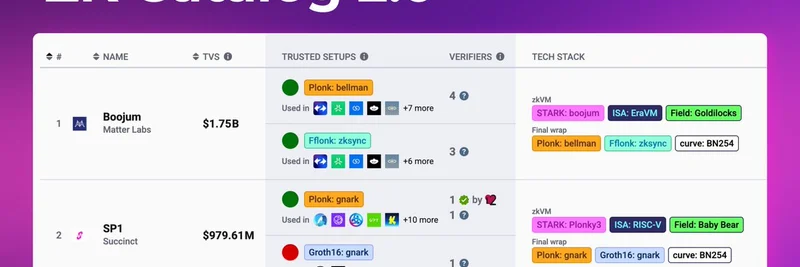Hey there, blockchain enthusiasts! If you're knee-deep in the world of Layer 2 solutions or just curious about how meme tokens and other crypto assets are scaling securely, you've got to check out the latest from L2Beat. They've just rolled out a major refresh to their ZK Catalog, now version 2.0, and it's all about making the hidden aspects of zero-knowledge (ZK) proofs more transparent. Zero-knowledge proofs, for the uninitiated, are cryptographic methods that allow one party to prove to another that a statement is true without revealing any additional information—super useful for privacy and efficiency in blockchain transactions.
This update introduces a public framework specifically designed to evaluate the trusted setups in ZK proving systems used across various L2 applications. The goal? To lay bare any hidden trust assumptions, establish clear standards, and turn this into the ultimate reference point for the ecosystem. Whether you're building on blockchain or trading meme coins on these platforms, understanding these underpinnings can help you gauge the real security behind the hype.
Why Trusted Setups Matter in ZK Systems
SNARKs (Succinct Non-interactive Arguments of Knowledge) and STARKs (Scalable Transparent Arguments of Knowledge) are everywhere in blockchain today. These proving systems power zk rollups, bridges, and apps, deriving their security from complex cryptographic setups. But here's the catch: many rely on "trusted setups," which are ceremonies where participants generate cryptographic parameters. If not done right, these can introduce trust risks—think potential backdoors if the process isn't transparent or diverse enough.
L2Beat's new ZK Catalog shines a light on these properties, especially the common reference strings in SNARKs. They've analyzed setups and proposed a simple 3-tier risk evaluation:
- Red (High Risk): Doesn't meet basic standards for transparency or participation.
- Yellow (Medium Risk): The ceremony is public and transparent with at least 30 contributions.
- Green (Low Risk): Meets yellow criteria plus at least 150 contributions.
This framework helps users quickly assess risks. For instance, the most popular setup, Aztec's Ignition from 2019, gets a green rating with 176 participants and is used by eight projects. On the flip side, setups from Loopring and Succinct Labs are flagged red, with L2Beat urging those teams to improve— they're even offering help!
Featured Projects and Their Stats
The catalog now hosts details on 12 key projects, including heavy hitters like Boojum from zkSync, SP1 from Succinct Labs, and Stone from StarkWare. It displays crucial metrics such as:
- Total Value Secured (TVS): How much value is locked in applications using these verifiers.
- Trusted Setups: Color-coded risk levels and details.
- Verifiers: Number of on-chain smart contracts and their verification status—L2Beat checks if what's proven matches what's verified on-chain.
- Tech Stack: Components like proof systems (Plonk, Groth16), VMs, and curves.
Here's a quick peek at the top ones from their announcement:
- Boojum (Matter Labs): $1.75B TVS, uses Plonk: bellman and Fflonk: zkSync, with a green setup rating.
- SP1 (Succinct): $979.61M TVS, Plonk: gnark and Groth16: gnark, but with a red setup for gnark.
- Stone (StarkWare): $735.06M TVS, STARK: Stone—no trusted setup needed, earning it a special shoutout for zero additional trust assumptions.
Other notables include Linea from Consensys, Scroll, RISC Zero, Zircuit, zkProver from Polygon Zero, zkSync Lite, Loopring, Aztec v1, and Intmax. If you're into meme tokens, note that many L2s hosting viral coins rely on these ZK systems for fast, cheap transactions without sacrificing security.
On-Chain Verifiers and Summary Page Updates
A big emphasis is on monitoring on-chain verifiers. L2Beat verifies that the proofs generated off-chain align perfectly with what's checked on Ethereum or other bases, preventing mismatches that could lead to vulnerabilities.
They've also tweaked the main summary page: swapping the "Type" column for "Proof System" in rollups. For ZK rollups, it links directly to the ZK Catalog entry; for optimistic ones, it points to state validation details. This makes navigating the vast world of L2s smoother, especially when scouting for platforms to launch or trade meme tokens.
Community Feedback and Next Steps
L2Beat is all about openness—they've posted a forum discussion for feedback on their evaluation framework. If something seems off or you have suggestions, jump in there.
And don't forget to explore the full ZK Catalog yourself. They're adding detailed pages for each prover, covering tech stacks, setups, and verifiers. As blockchain tech evolves, tools like this are gold for staying informed and secure, whether you're a dev, trader, or just a meme coin aficionado looking for the next big thing on L2.
What do you think of this update? Does it change how you'll evaluate L2 projects? Share your thoughts in the comments below!


